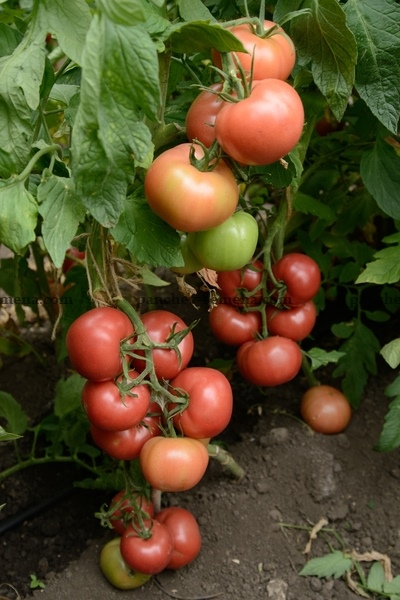
- Authors: Panchev Yu. I., Panchev Yu. Yu.
- Year of approval: 2018
- Category: hybrid
- Growth type: indeterminate
- Appointment: fresh consumption
- Ripening period: early
- Ripening time, days: 93-95
- Growing conditions: for open ground, for film greenhouses
- Marketability: high
- Transportability: high
Indeterminate tomato hybrid Pobeda from the well-known breeder Yu.I. Panchev attracts the attention of summer residents with good marketable properties of fruits, their abundant return and an extended ripening period. Cultivation is carried out both in open and closed ground, in greenhouses. And also a hybrid is found under the name Pobeda F1.
Description of the variety
The tomato forms tall bushes, reaching 200-250 cm. Shoots are weakly leafy, almost glabrous. The inflorescences are intermediate. The leaves are long, colored green. Fruit clusters contain 6-8 tomatoes.
The main qualities of the fruit
At the stage of ripening, the skin tone of tomatoes changes from light green to raspberry. Fruits are large, weighing 200-220 g, rounded, with weak ribs.
Taste characteristics
Juicy fruits with excellent salad flavor. Suitable for fresh consumption.
Ripening and fruiting
This is an early hybrid that yields fruits on the 93-95 days from the moment the shoots appear.
Yield
In terms of the yield of marketable fruits - up to 98% - the hybrid can be attributed to the record holders. Average yields are 21 kg / sq. m. In the first fees, it is slightly lower.
The timing of planting seedlings and planting in the ground
The seeds of the hybrid begin to germinate 60-65 days before transplanting to a permanent place in a greenhouse or soil. The best time is considered to be the 3rd decade of March or the beginning of April. After emergence, the plants are gradually prepared for transplantation. They are sent to the open ground no earlier than the beginning of June, after the end of the night frost period. Tomatoes are transferred to greenhouses in May or April, based on the regional characteristics of the climate.

Growing tomato seedlings is an extremely important process, because it largely depends on whether the gardener will be able to harvest at all. All aspects must be taken into account, from seedbed preparation to planting in the ground.
Landing scheme
Plants are arranged quite densely, at a distance of 30 × 50 cm. Up to 4 bushes are placed per 1 m2. This will avoid excessive thickening of the plantings.

Growing and care
The bushes are formed into 1 stem, they must be tied up with synthetic ropes as they climb. Pinching the top is carried out without waiting 1 month before the end of fruiting or earlier if the shoots reach the roof of the greenhouse. In the open field, you can do without these measures. The land for planting is prepared by adding sand and humus to the garden turf, and ash and superphosphate are mixed with them.
The lower leaves on the bushes are cut off as they age. So it will be possible to increase the early maturity of tomatoes, to increase the total number of successfully formed ovaries. And also the timely removal of unnecessary overgrowth will help prevent infection of the bushes with various diseases.




A plant needs different micronutrients at each stage of growth. All fertilizers can be divided into two groups: mineral and organic. Folk remedies are often used: iodine, yeast, bird droppings, eggshells.
It is important to observe the rate and period of feeding. This also applies to folk remedies and organic fertilizers.
Disease and pest resistance
Tomato does not suffer from TMV and Alternaria. But it is not protected from other external influences. Aphids, the Colorado potato beetle, as well as a spider mite, which often spoil plants in greenhouses, are dangerous among pests for him. Bushes should be regularly inspected, if pests are detected, appropriate chemical treatment of shoots and leaves should be performed. Two or three times a season it will be useful to carry out preventive spraying with Bordeaux liquid.


Resistant to adverse weather conditions
Hybrid Pobeda successfully tolerates most types of exposure. Tomatoes are able to cope with a lack of moisture, prolonged periods of rain, lack of sunlight. All these factors do not have a serious impact on the processes of its vegetation.
Review overview
The opinions of summer residents about Pobeda tomatoes are not too clear-cut. Plants are often criticized for their very high stem height, which causes problems in harvesting. In this case, fruit clusters are formed almost along the entire length of the central shoot, which somewhat compensates for the inconvenience. The palatability of the fruit is also highly rated, noting its sweetness and juiciness. And also summer residents mention that tomatoes tolerate transportation well, they are stored for a long time, without losing their basic qualities.
The hybrid is praised for its overall unpretentiousness. It bears fruit abundantly even in bad weather conditions. Many people mention that he gives ovaries amicably and well. The disease resistance of the hybrid is also assessed as high. It does not suffer from fungal infections even when other plants in the greenhouse are affected.
By use, this tomato is referred to as universal. Summer residents note that the fruits keep their shape well when cutting, give a special rich taste to juices and tomato paste.

























































































